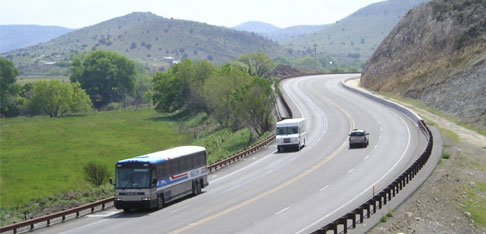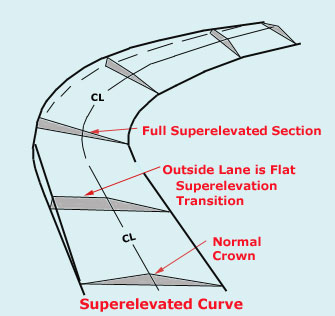For service in the Atlanta, Georgia area contact or call us:
Pavement Drainage Problems
Pavement drainag problems are dangerous on high-speed highways. The traveling public is totally unaware of pavement drainage problems or where on the highway a dangerous situation may exist. They depend on the maintenance engineers to keep the public roadways safe.
We will discuss 2 surface drainage problems and what causes these problems. Pavement drainage problems occur most often in heavy flash floods rain events. The sky opens up and drops buckets of water in a few minutes.
Drainage engineers are aware of flash flood events and design pavements to handle such water runoff events. Problems with pavement drainage on highways usually develop after the roadway has been in service for a long period and the pavement fails. The pavement surface has to be overlaid with asphalt.
The centerline crown and the transition from a superelevation in a horizontal curve to a tangent section are 2 locations that can get overlooked by the maintenance engineer and the paving contractor. The cross slopes are changed and the storm water no longer moves as designed.

Pavement Drainage Problems
Caused by Centerline Crowns
Roadways are designed with a crown in the middle of the roadway. This is a standard means to discharge water from the roadway surface and provide adequate pavement drainage.
I have seen many accidents which were caused because of incorrect construction of the crown of the roadway and many more roadways where the centerline crown was destroyed because of improper maintenance of the roadway. Often crowns are removed when a roadway pavement surface is overlaid with asphalt.
Good pavement drainage directs water along the shortest route to the roadway shoulder. The less time water stays on a roadway, the safer the highway is for the traveling public.
Pavement drainage problems are created when highways are overlaid with asphalt and the roadway crown is not protected. Two percent (1/4 inch per foot) provides good drainage for two and four lanes roadways. Water will move efficiently from the centerline of the roadway to the shoulder of the roadway even for steep graded highways.
Part of our hydroplaning investigation is to survey the roadway surface to determine the cross slope (crown) of the roadway and also to determine the grade of the highway.
Our investigation of an accident scene in North Georgia revealed that the cross slope was so out of compliance that water actually flowed from the far side (northbound traffic lane) of the roadway to the near (southbound) travel lanes. This created a hazardous condition. The water flowed in the southbound lanes and reached a depth sufficient for hydroplaning. This was a very serious pavement drainage problem.
Our case involved two separate accidents inwhich both vehicles hydroplaned and ran-off-the-road. The second hydroplaning vehicle killed an individual that had stopped to help the driver in the first accident.

Superelevation Transitions
Pavement drainage problems often occur in superelevation of high-speed highways. An often overlooked area of the roadway that creates havoc for driver traveling in the rain is the transition from a superelevation to a normal crown section and from a crown section to a superelevation.
The direction of pavement drainage is changed during the transition. Water flowing toward the edge of the pavement is redirected to the inside lane in the superelevation transition. This causes the water to stay on the pavement surface longer and travel a longer distance. During a rain, water gets deeper as it travels on the pavement... the longer the travel path the deeper the water.
Water depth over a tenth of an inch on a high-speed highway is a situation waiting for a hydroplaning accident. In hydroplaning vehicles, drivers have no control of steering or braking. The vehicles go in the direction it was traveling at the time the hydroplaning started. If another vehicle is in its path, a collision occurs which usually results in serious injury or death.
Areas of pavement drainage problems must be monitored by maintenance personnel and addressed before accidents occur.
Pavement Drainage Problems
Careful evaluation of improper centerline crowns and transitions from superelevation should be made regularly. These are areas where pavement drainage problems can occur and cause hydroplaning accidents during rain events.
Further Reading About Hydroplaning
Hydroplaning caused by roadway defects
Qualifications of a good hydroplaning expert
Hydroplaning article written by Elvin Aycock for the American Institute of Hydrology.
Home Page - Atlanta Engineering Services
Ruts cause hydroplaning where the asphalt and the subgrade has failed.
Hydroplaning on roadways while transiting from superelevation to normal crown
Pavement drainage can be a problem in vertical curve sags and in transitions from superelevations to tangent sections.
More pavement drainage problems occur when the centerline crown is destroyed and superelevation transitions hold water.
